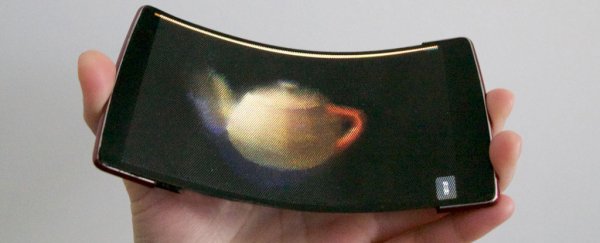Canadian researchers have developed what they are claiming is the world's first holographic flexible smartphone, with a bendable display that allows multiple people looking at the device to see different 3D images depending on their perspective.
To view the device, called Holoflex, you don't need those dumb plastic glasses you have to wear in the cinema to watch 3D movies, and it doesn't employ head tracking to tailor the appearance to the viewer, as seen in devices like the newer Nintendo 3DS.
Instead, the smartphone sports a Full HD LED display with 1,920 x 1,080 resolution – albeit one that's flexible, as you can see in the video below.
So how does it actually work? Well, when the device displays images, it renders them into 12-pixel wide circular blocks. Over the top of the display is a thin 3D-printed microlens array, consisting of over 16,000 fisheye lenses.
When the pixel blocks are viewed through the lens array, it makes the images look 3D to the viewer depending on their angle, when in fact they're actually only two-dimensional.
The one downside to this technique is it makes the appearance of the display decidedly more pixellated. Once the Full HD resolution is effectively down-sampled via the image-rendering process, you're left with a pretty chunky-looking 160 x 104 resolution image.
Still, it's an impressive effect that makes 3D images viewable by multiple people simultaneously, and the team that developed it says the technology could change how we use our devices.
"HoloFlex offers a completely new way of interacting with your smartphone," said one of the researchers, Roel Vertegaal from the Human Media Lab at Queen's University in Canada. "It allows for glasses-free interactions with 3D video and images in a way that does not encumber the user."
And while we've seen curved and flexible displays before, this time, it's not just for aesthetic purposes. The HoloFlex incorporates bending and flexing the device as another kind of control, which the team calls "Z-Input".
You can see the Z-Input at work in the video below, with the researchers demonstrating its potential for use in applications like 3D model editing.
For example, with the touchscreen, you could manipulate virtual objects onscreen on X and Y axes – as much as any smartphone or tablet allows – but flexing the display could rise and lower the object on the Z axis.
If coupled with sensors that can detect the user and the environment around them, other interesting applications could be possible too.
"By employing a depth camera, users can also perform holographic video conferences with one another," said Vertegaal. "When bending the display users literally pop out of the screen and can even look around each other, with their faces rendered correctly from any angle to any onlooker."
The video also demonstrates how HoloFlex could be used for gaming. With an Angry Birds-style tech demo, bending the screen would let you control the slingshot without having to slide your finger across the display.
It's obviously early days for the HoloFlex, which is just a prototype for now, but we can't wait to see where this technology leads.
The research is being presented this week at the ACM CHI 2016 conference in California, and you can see a video showing off HoloFlex's functionality below:
